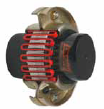The next info is important when making a Grid coupling choice:
Description of motor or engine, the horse power (or KW), and RPM at slowest coupling pace whilst underneath load
Description in the driven tools
Shaft and keyway sizes plus the style of match for driver and driven equipment (clearance or interference)**
Shaft separation (BSE)
Bodily room limitations (see Application Worksheet)
Ascertain what the environmental disorders will likely be, such as temperature, corrosive ailments, interference from surrounding structures, and so forth.
By default, sizes 1020 – 1090 will likely be clearance match, sizes 1100 – 1200 are going to be interference fit.
** Machines all bores and keyways to meet the dimensional and tolerance specs per ANSI/AGMA 9002-B04 for inch bores, or ISO 286-2 for metric bores.
Standard grid couplings consist of two grid hubs, a grid spring, as well as a cover assembly. When the shaft separation calls for a spacer style coupling, the coupling will consist of two shaft hubs, two spacer hubs, a grid spring, as well as a horizontal cover assembly.
Formulas Applied To Calculate Torque:
Application Torque (in-lbs) = ( horse power x 63025 ) /RPM
Application Torque (Nm) = ( horse energy x 9550 ) /RPM
Choice Torque = Application Torque x Services Aspect
Substantial Peak Loads and Brake Applications
For applications exactly where substantial peak loads or substantial braking torques may very well be current, the next added details is going to be vital:
Technique peak torque and frequency
Duty cycle
Brake torque rating
The choice torque formula is similar to the formula shown over except the application torque ought to be doubled just before applying the service issue.
Application Torque (in-lbs) = ( horse power x 63025 ) /RPM
Application Torque (Nm) = ( horse energy x 9550 ) /RPM
Variety Torque = two x Application Torque x Services Aspect
Techniques In Deciding on A Grid Coupling
Step one: Identify the application torque using the formula shown above.
Stage two: Decide on the Service Aspect from your charts .
For applications not displayed use the chart proven to the suitable. Identify the Choice Torque making use of the formula shown over.
Phase three: Working with the assortment torque as calculated, refer for the Efficiency Chart
Stage 4: Assess the maximum bore to the dimension picked and guarantee the required bore sizes will not exceed the maximum allowable. Should the  demanded bore dimension is larger, phase as much as the subsequent size coupling and test to discover in case the bore sizes will fit.
demanded bore dimension is larger, phase as much as the subsequent size coupling and test to discover in case the bore sizes will fit.
Phase 5: Employing the picked coupling size, assess the bore and keyway sizes
Stage six: Contact your community industrial supplier together with the portion numbers to place sizes together with the charts for UPC component numbers.
